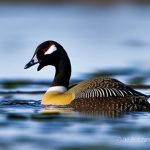Canadian geese are a common sight in North America, with their distinctive honking and V-shaped formations as they migrate across the continent. While these birds can be beautiful to observe, they can also become a nuisance, especially when they gather in large numbers around docks and bodies of water. This blog post aims to provide tips on how to manage geese in a friendly and non-harmful way, ensuring that both humans and geese can coexist peacefully.
Key Takeaways
- Canadian geese are attracted to open water and grassy areas near water sources.
- Non-harmful deterrents such as decoys, lasers, and dogs can be effective in keeping geese away.
- Physical barriers such as fencing and netting can prevent geese from landing on docks.
- Sound and visual repellents such as loud noises and reflective tape can also deter geese.
- Keeping the environment clean and unattractive to geese by removing food sources and debris can help prevent them from docking.
Understanding the Behavior of Canadian Geese
To effectively manage geese, it is important to understand their behavior. Canadian geese are migratory birds, meaning they travel long distances between their breeding grounds in the north and their wintering grounds in the south. During migration, they stop at various locations to rest and feed. This is why they are often attracted to areas with bodies of water, such as lakes, ponds, and rivers.
Geese are also social animals and tend to gather in large flocks. They are attracted to areas where they feel safe and have easy access to food. Docks provide an ideal location for geese as they offer both safety from predators and a potential food source. Understanding these patterns can help in implementing effective deterrents.
Implementing Non-Harmful Deterrents for Geese
It is important to use non-harmful methods to deter geese from gathering on docks. Harmful methods such as trapping or shooting should be avoided as they can cause unnecessary harm to the birds. Instead, there are several non-harmful deterrents that can be used.
One effective method is the use of decoys. Placing decoy geese near the dock can trick real geese into thinking the area is already occupied, discouraging them from landing. Another method is the use of reflective tape or flags. These visual deterrents create a sense of danger for the geese and can make them feel uncomfortable, leading them to seek another location.
Creating Physical Barriers to Prevent Geese from Docking
Physical barriers can be an effective way to prevent geese from landing on docks. Fencing and netting are commonly used to create a physical barrier that prevents geese from accessing the dock. The fence should be at least three feet high and have small enough gaps to prevent the geese from squeezing through. Netting can be installed over the dock to create a barrier that prevents the geese from landing.
When installing physical barriers, it is important to ensure they are properly secured and maintained. Regular inspections should be conducted to check for any damage or gaps that may allow geese to access the dock. Additionally, it is important to regularly clean the area around the dock to remove any food sources that may attract geese.
Utilizing Sound and Visual Repellents to Keep Geese Away
Sound and visual repellents can also be effective in deterring geese from gathering on docks. Noise machines that emit loud sounds or distress calls can create a sense of danger for the geese and discourage them from landing. Scarecrows or other visual deterrents that resemble predators can also be effective in keeping geese away.
When using sound and visual repellents, it is important to properly position them and regularly move them around. Geese can become accustomed to these deterrents if they remain in the same location for too long. By regularly changing their position, it keeps the geese on edge and less likely to become comfortable with their presence.
Maintaining a Clean and Unattractive Environment for Geese

Keeping the area around docks clean and unattractive to geese is an important step in managing their presence. Geese are attracted to areas with easy access to food, so removing any potential food sources can help deter them. This includes regularly cleaning up any spilled food or garbage around the dock.
It is also important to remove any vegetation or shrubs near the dock that may provide cover for geese. By keeping the area open and unobstructed, it makes it less appealing for geese to gather. Additionally, regularly mowing the grass around the dock can make it less attractive to geese as they prefer longer grass for nesting.
Educating on the Importance of Keeping Geese off Docks
Educating others on the importance of keeping geese off docks can help create a collective effort in managing their presence. Geese can cause damage to docks and surrounding areas through their droppings, which can be unsightly and pose health risks. By explaining these negative impacts to others, it can encourage them to take action in deterring geese from gathering on docks.
One way to educate others is by sharing information through community newsletters or social media groups. Providing tips and resources on how to manage geese in a friendly and non-harmful way can empower others to take action. Additionally, organizing community clean-up events around docks can help raise awareness of the importance of maintaining a clean and unattractive environment for geese.
Seeking Professional Help for Geese Control
If geese become a persistent problem despite implementing various deterrents, it may be necessary to seek professional help for geese control. There are companies that specialize in humane geese management and can provide effective solutions tailored to specific situations. These professionals have the knowledge and experience to implement strategies that are both effective and non-harmful to the geese.
When seeking professional help, it is important to find a reputable company that has experience in geese management. Reading reviews and asking for recommendations from others who have dealt with similar issues can help in finding a reliable professional.
Developing a Long-Term Strategy for Geese Management
Developing a long-term strategy for geese management is crucial in maintaining a geese-free environment around docks. This involves implementing a combination of deterrents and regularly monitoring their effectiveness. It is important to be proactive and adjust tactics as needed to ensure the geese do not become accustomed to the deterrents.
A long-term strategy should also include regular maintenance and inspections of physical barriers, as well as ongoing efforts to keep the area clean and unattractive to geese. By taking a proactive approach and consistently implementing deterrents, it becomes easier to manage geese and prevent them from gathering on docks.
Monitoring Geese Activity and Adjusting Tactics Accordingly
Monitoring geese activity is an important part of managing their presence. Regularly observing their behavior and noting any changes can help in adjusting tactics accordingly. For example, if geese are still landing on the dock despite the use of decoys, it may be necessary to try a different deterrent such as sound or visual repellents.
It is also important to monitor the effectiveness of physical barriers and regularly inspect them for any damage or gaps. By staying vigilant and adjusting tactics as needed, it becomes easier to maintain a geese-free environment around docks.
Collaborating with Neighbors to Address Geese Issues in the Area
Collaborating with neighbors can be an effective way to address geese issues in the area. By working together, it becomes easier to implement deterrents and maintain a geese-free environment. This can involve sharing resources such as decoys or noise machines, as well as coordinating efforts to keep the area clean and unattractive to geese.
Regular communication with neighbors can also help in monitoring geese activity and adjusting tactics accordingly. By sharing observations and experiences, it becomes easier to develop effective strategies for managing geese in the area.
Managing geese in a friendly and non-harmful way is essential for maintaining a peaceful coexistence between humans and wildlife. By understanding the behavior of Canadian geese and implementing non-harmful deterrents, it becomes possible to prevent them from gathering on docks. Creating physical barriers, utilizing sound and visual repellents, and maintaining a clean environment are all effective strategies in managing geese. Additionally, educating others, seeking professional help when needed, and developing a long-term strategy are important steps in ensuring geese management is successful. By taking action and implementing these tips, it is possible to manage geese in a way that is both friendly and non-harmful.
If you’re looking for effective ways to keep Canadian geese off your dock, you might find this article on Poultry Wizard helpful. They have a range of resources on keeping chickens, including a guide on building an A-frame chicken coop (source). While the article focuses on chickens, some of the strategies and techniques mentioned could be adapted to deter geese from your dock. It’s worth checking out their other articles too, such as the one on a chicken coop in Muskegon (source) or their garden chicken coop ideas (source).
FAQs
What are Canadian geese?
Canadian geese, also known as Canada geese, are large waterfowl native to North America. They are known for their distinctive black heads and necks, white patches on their faces, and honking calls.
Why do Canadian geese congregate on docks?
Canadian geese are attracted to docks because they provide a safe and elevated platform for resting, nesting, and foraging. Docks also offer protection from predators and easy access to water for feeding.
Why is it important to keep Canadian geese off docks?
Keeping Canadian geese off docks is important to prevent damage to the dock structure, reduce the risk of slip and fall accidents caused by goose droppings, and minimize conflicts between humans and geese. Additionally, geese droppings can contribute to water pollution.
How can Canadian geese be deterred from docks?
There are several humane methods to deter Canadian geese from docks, including installing physical barriers such as netting or fencing, using visual deterrents like scarecrows or predator decoys, employing sound deterrents such as noise makers or ultrasonic devices, and implementing habitat modification techniques to make the area less attractive to geese.
Is it legal to harm Canadian geese?
Canadian geese are protected under the Migratory Bird Treaty Act in the United States and similar legislation in Canada. It is illegal to harm, harass, or kill Canadian geese without proper permits. It is important to use non-lethal and humane methods to deter geese from docks.
Meet Walter, the feathered-friend fanatic of Florida! Nestled in the sunshine state, Walter struts through life with his feathered companions, clucking his way to happiness. With a coop that’s fancier than a five-star hotel, he’s the Don Juan of the chicken world. When he’s not teaching his hens to do the cha-cha, you’ll find him in a heated debate with his prized rooster, Sir Clucks-a-Lot. Walter’s poultry passion is no yolk; he’s the sunny-side-up guy you never knew you needed in your flock of friends!







